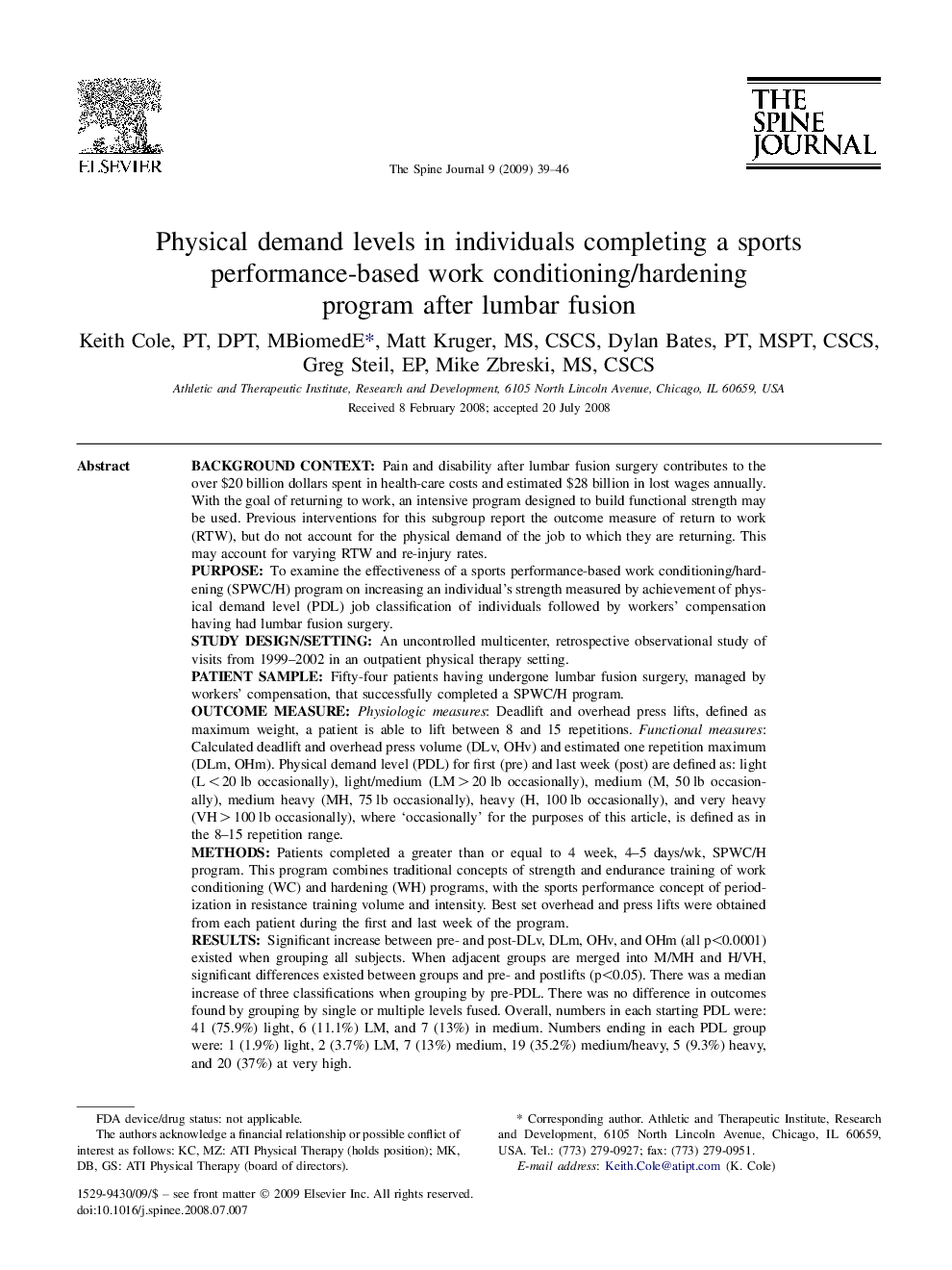| کد مقاله | کد نشریه | سال انتشار | مقاله انگلیسی | نسخه تمام متن |
|---|---|---|---|---|
| 4099068 | 1268631 | 2009 | 8 صفحه PDF | دانلود رایگان |

Background contextPain and disability after lumbar fusion surgery contributes to the over $20 billion dollars spent in health-care costs and estimated $28 billion in lost wages annually. With the goal of returning to work, an intensive program designed to build functional strength may be used. Previous interventions for this subgroup report the outcome measure of return to work (RTW), but do not account for the physical demand of the job to which they are returning. This may account for varying RTW and re-injury rates.PurposeTo examine the effectiveness of a sports performance-based work conditioning/hardening (SPWC/H) program on increasing an individual's strength measured by achievement of physical demand level (PDL) job classification of individuals followed by workers' compensation having had lumbar fusion surgery.Study design/settingAn uncontrolled multicenter, retrospective observational study of visits from 1999–2002 in an outpatient physical therapy setting.Patient sampleFifty-four patients having undergone lumbar fusion surgery, managed by workers' compensation, that successfully completed a SPWC/H program.Outcome measurePhysiologic measures: Deadlift and overhead press lifts, defined as maximum weight, a patient is able to lift between 8 and 15 repetitions. Functional measures: Calculated deadlift and overhead press volume (DLv, OHv) and estimated one repetition maximum (DLm, OHm). Physical demand level (PDL) for first (pre) and last week (post) are defined as: light (L < 20 lb occasionally), light/medium (LM > 20 lb occasionally), medium (M, 50 lb occasionally), medium heavy (MH, 75 lb occasionally), heavy (H, 100 lb occasionally), and very heavy (VH > 100 lb occasionally), where ‘occasionally’ for the purposes of this article, is defined as in the 8–15 repetition range.MethodsPatients completed a greater than or equal to 4 week, 4–5 days/wk, SPWC/H program. This program combines traditional concepts of strength and endurance training of work conditioning (WC) and hardening (WH) programs, with the sports performance concept of periodization in resistance training volume and intensity. Best set overhead and press lifts were obtained from each patient during the first and last week of the program.ResultsSignificant increase between pre- and post-DLv, DLm, OHv, and OHm (all p<0.0001) existed when grouping all subjects. When adjacent groups are merged into M/MH and H/VH, significant differences existed between groups and pre- and postlifts (p<0.05). There was a median increase of three classifications when grouping by pre-PDL. There was no difference in outcomes found by grouping by single or multiple levels fused. Overall, numbers in each starting PDL were: 41 (75.9%) light, 6 (11.1%) LM, and 7 (13%) in medium. Numbers ending in each PDL group were: 1 (1.9%) light, 2 (3.7%) LM, 7 (13%) medium, 19 (35.2%) medium/heavy, 5 (9.3%) heavy, and 20 (37%) at very high.ConclusionsPost-lumbar spinal fusion patients are typically at the light PDL (<20 lb occasionally) on completion of traditional physical therapy program. After an SPWC/H program, significant increase strength of deadlift and overhead lift volume and one repetition maximum demonstrated a median three-level increase in classification of PDL. We were also able to determine that there was no difference in strength outcome between those with a single- vs. multiple-level fusion surgery. Although the vast majority of individuals entered the program at the lowest PDL (20 lb or less occasionally), more than 80% of patients completed the program at PDL of medium (50 lb occasionally) or above, and 37% of patients achieved the maximum PDL (over 100 lb occasionally). Future studies are needed to determine if increases in strength determined by PDL classification such as these relates to increased RTW rates and decreased re-injury rates.
Journal: The Spine Journal - Volume 9, Issue 1, January 2009, Pages 39–46